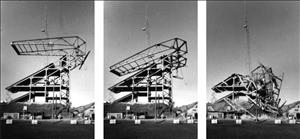On February 25, 1987, at 10:07 a.m., a section of the Husky Stadium on the University of Washington campus, which is under construction, collapses. It is a 215-foot addition to the bleachers, which becomes, in about 12 seconds, a 250-ton pile of twisted steel.
A Buckle in a Tube
In May 1986, Lydig Construction Company, a 22-year-old firm from Spokane, was awarded the contract to construct the $12.9 million, 13,700-seat addition to Husky Stadium. The steel contractor was Canron Construction Company from Toronto.
By February 25, the first two of nine sections of the addition under construction were nearing completion. At 8:30 a.m. there was a crew of about 40 men working on the structure. At about 9 a.m., an ironworker spotted a buckle in a 28-inch diameter tube that supported the overhanging roof. Supervisor Wally Sharp ordered most of the workers to evacuate the site.
And then it happened.
"Oh My God! The Stadium's Going!"
Mike Lude, Washington Athletic Director, a central figure in proposing the addition to the stadium and in raising funds for it, was concluding a staff meeting in his office overlooking the stadium. From an adjacent office, his secretary, Helen Gulickson, screamed, "Oh my God! The stadium's going!"
Everyone at the meeting jumped up and ran to the windows. They witnessed the 140-high bleachers fall to the ground and become a gigantic mass of twisted metal.
Mike Lude stated he was "a little bit in awe; as he saw the structure start to crumble. It's kind of like having a new offspring and having something happen to it .... It was unbelievable. I couldn't believe what I was seeing, but I was seeing it and hearing it."
Recording the Downfall
Another meeting attendee, Chuck Niemi, UW Sports Information Director, said that initially, "Everybody went blank." The first words that broke the silence were a few one-word expletives. After recovering their senses, Mike Lude and the others rushed to the site to find out if there were any injuries or worse.
Meanwhile, that morning photographer John Stamets (1949-2014) had been riding his bicycle past the stadium, and had stopped to take a few pictures. As he was doing so, the stadium began shaking violently and then began its descent. In 12 seconds, by advancing the film by hand, Stamets captured nine pictures of the descent. Thus we have an amazing photographic record of the historic downfall of the Husky Stadium. (Five years after capturing the campus collapse, Stamets joined the faculty there, serving for 22 years as a photographer and lecturer in the UW architecture department.)
"We Ran Like Hell"
The last worker off the structure was painting contractor Ron Toquinto. He was halfway up the structure when his foreman said "Hey, come on down. There's something about this; we want you all out of here."
Toquinto said, "Just as I was walking out from underneath it, it started vibrating then violently shaking. It starting unscrewing itself and folded right to the ground." Again, he stated, "It just started wobbling and fell down like it was the Narrows Bridge or something. When I heard it start to go, we ran like hell."
All the workers got away in time. The only possible fatality was a cat, the ironworkers' mascot. But a few hours later, even the cat was found in the rubble, alive and apparently unharmed.
All Fall Down
While the stadium was under construction, nine guylines (wire cables) were used to support the structure. Six of the guylines were removed too early, which caused the 250 tons of steel to start swaying and then to collapse. Preliminary damage estimates ranged from $500,000 to $1,000,000.
The collapse was a setback. Nevertheless, the stadium addition was completed in time for the football team's first home game of the season on September 5, 1987, Huskies against Stanford. The Huskies won, 31-21.

